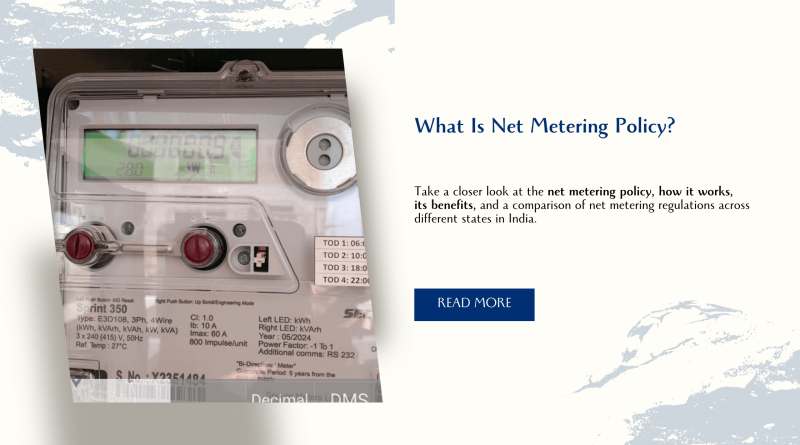What Is Net Metering Policy?
As the world moves towards sustainable energy solutions, solar power has become a popular choice for both residential and commercial users. To encourage the adoption of solar energy, many governments, including India, have introduced net metering policies. This policy is a crucial mechanism that makes solar power more financially viable for users by allowing them to export surplus energy back to the grid and get compensated for it.
In this blog, we’ll take a closer look at the net metering policy, how it works, its benefits, and a comparison of net metering regulations across different states in India.
Table of Contents
What is Net Metering?
Net metering is a billing mechanism that allows solar energy system owners to receive credits for the excess electricity they generate. When your solar panels produce more electricity than you consume, the surplus is exported back to the grid, and in return, you earn credits. These credits can then offset the cost of the electricity you consume from the grid when your solar system isn’t producing enough power (like during the night or cloudy days).
This creates a “net” balance between the energy you consume from the grid and the energy you generate, hence the name net metering.
How Does Net Metering Work?
Net metering works through the use of a bi-directional meter, which tracks both the energy consumed from the grid and the energy exported to the grid. Here’s a breakdown of the process:
1. Energy Generation: Your solar panels generate electricity during the day, with the energy being consumed directly by your home or business.
2. Surplus Energy Export: If your solar panels produce more energy than you need, the excess electricity is sent back to the grid, and your bi-directional meter tracks how much energy you export.
3. Energy Import: During times when your solar panels aren’t producing enough energy (such as at night), you consume electricity from the grid. The bi-directional meter tracks this imported electricity as well.
4. Billing and Credits: At the end of the billing cycle, your utility company calculates the difference between the energy you consumed from the grid and the energy you exported. If you exported more energy than you consumed, you will receive credits that can offset future bills.
Benefits of Net Metering Policy
Net metering offers several benefits for solar energy users, making it one of the most popular mechanisms for promoting renewable energy. Here are some of its key benefits:
1. Cost Savings: By exporting surplus energy to the grid, you can significantly reduce your electricity bills. The credits earned through net metering can be used to offset future electricity costs.
2. Incentive for Solar Adoption: Net metering encourages more people to adopt solar energy, as it provides a clear financial benefit by reducing energy costs.
3. Efficient Use of Energy: It ensures that no solar energy generated goes to waste. Any excess power is sent to the grid and used by other consumers.
4. Environmental Benefits: Net metering helps reduce reliance on fossil fuels and supports the growth of clean, renewable energy sources, leading to a reduction in carbon emissions.
5. Long-Term Financial Gains: Over time, solar users can potentially recoup their initial solar installation costs, making solar energy a profitable long-term investment.
Key Components of Net Metering
To understand net metering more clearly, it’s important to know about the core elements involved:
Bi-Directional Meter: This is a special type of electricity meter used in net metering. It tracks both the amount of electricity consumed from the grid and the amount exported back to the grid.
Net Energy Usage: The difference between the electricity consumed from the grid and the electricity exported is the net energy usage. This determines whether you owe money or receive credits.
Credit System: If you export more electricity than you consume in a billing cycle, the utility company gives you a credit, which can be used to offset future electricity consumption.
Power Purchase Agreement (PPA): In some cases, a PPA is signed between the consumer and the utility company, outlining the terms for exporting energy and the rate of compensation.
Net Metering Policies in India: State-Wise Comparison
Net metering policies in India vary by state, with each state having its own set of regulations regarding the size of the solar system, compensation rates, and eligibility criteria. Below is a table summarizing the net metering policies across key states in India:
| State | Net Metering Availability | Eligible System Size (kW) | Maximum Capacity (kW) | Compensation for Surplus |
|---|---|---|---|---|
| Delhi | Yes | 1 kW to 1 MW | 100% of sanctioned load | Credit at retail tariff rate |
| Maharashtra | Phasing out for large systems | 1 kW to 500 kW | 100% of sanctioned load | Lower than retail rate |
| Gujarat | Yes | 1 kW to 1 MW | 50% of sanctioned load | Credit at retail tariff rate |
| Tamil Nadu | Yes | 1 kW to 999 kW | 100% of sanctioned load | Credit at retail tariff rate |
| Karnataka | Yes | 1 kW to 1 MW | 100% of sanctioned load | Credit at retail tariff rate |
| Uttar Pradesh | Yes | 1 kW to 2 MW | 100% of sanctioned load | Credit at retail tariff rate |
| Rajasthan | Yes | 1 kW to 1 MW | 100% of sanctioned load | Credit at retail tariff rate |
| Haryana | Yes | 1 kW to 2 MW | 100% of sanctioned load | Credit at retail tariff rate |
| Kerala | Yes | 1 kW to 1 MW | 80% of sanctioned load | Credit at retail tariff rate |
| Punjab | Yes | 1 kW to 1 MW | 80% of sanctioned load | Credit at retail tariff rate |
State-Wise Key Highlights for Net Metering Policies
1. Delhi: Offers net metering for systems up to 1 MW and compensates surplus energy at the retail rate.
2. Maharashtra: Net metering is phasing out for larger systems, but smaller systems can still avail benefits. Surplus energy compensation is slightly lower than the retail rate.
3. Gujarat: Allows net metering for up to 50% of the sanctioned load with compensation at the retail rate.
4. Tamil Nadu: Net metering available for systems up to 999 kW, with credit given at retail tariff rates.
5. Karnataka: Systems up to 1 MW are eligible, and compensation is provided at the retail rate.
6. Uttar Pradesh: Offers net metering for systems as large as 2 MW, making it favorable for commercial installations.
Challenges and Limitations of Net Metering
Despite its many benefits, there are some challenges and limitations with net metering:
1. Phasing Out for Larger Systems: Some states, like Maharashtra, are gradually phasing out net metering for larger commercial systems in favor of gross metering, where consumers are paid a fixed rate for all the electricity they generate, regardless of consumption.
2. Capacity Limits: Many states cap the size of the solar PV system eligible for net metering, often linked to the consumer’s sanctioned load. Exceeding these limits can disqualify you from receiving full benefits.
3. Lower Compensation Rates: In certain states, compensation for surplus energy is lower than the retail rate, reducing the financial benefit for consumers who export significant amounts of energy to the grid.
Conclusion
The net metering policy is a crucial enabler for solar energy adoption, providing a way for consumers to offset their electricity bills by exporting surplus energy to the grid. While the specific regulations and compensation rates vary from state to state in India, net metering remains one of the most beneficial mechanisms for encouraging renewable energy. Understanding the policies in your state is essential for maximizing the financial benefits of your solar installation.
Ready to Save on Electricity Bills with Solar Power?
With Net Metering, you can drastically reduce your electricity costs by generating your own solar power and sending any excess back to the grid. It’s time to harness the sun’s energy and make a positive impact on both your wallet and the environment!
At SolarClue, we make the transition to solar simple, efficient, and affordable. Whether you’re a homeowner, business, or institution, our team of solar experts will guide you through the process—from installation to maintenance—so you can start saving from day one.
🌞 Take the first step towards energy independence today!
🔋 Get your solar consultation now!
Contact SolarClue or call us at +91-888-4444-830 to explore the best solar solutions for your home or business.
Go Solar. Save More. Power Your Future with SolarClue!
FAQs
1. What happens to excess solar energy generated in net metering?
Excess energy is sent back to the grid, and you earn credits that can offset your electricity consumption during the next billing cycle.
2. Is net metering available in all states of India?
Net metering is available in most states, though the policies and eligibility criteria vary.
3. Can I earn money with net metering?
While net metering doesn’t typically result in direct cash payments, you can earn credits that reduce your future electricity bills.
4. What is the difference between net metering and gross metering?
In net metering, you are compensated for the net energy exported to the grid. In gross metering, you are paid a fixed rate for all energy generated, irrespective of consumption.
5. Can commercial buildings benefit from net metering?
Yes, many states offer net metering for commercial installations, though there may be caps on system size.



